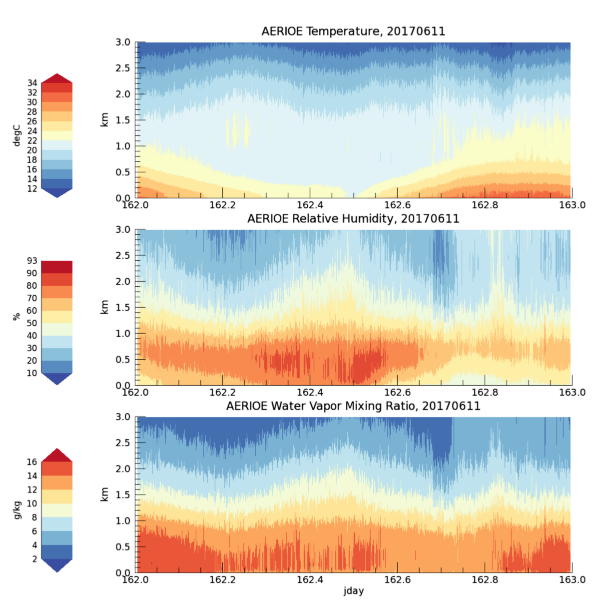New VAP Available for Atmospheric Emitted Radiance Interferometer
Published: 18 November 2019

The Atmospheric Emitted Radiance Interferometer Optimal Estimation (AERIOE) value-added product (VAP) is a new data product that provides boundary layer profiles of temperature and water vapor mixing ratio and liquid cloud retrievals.
AERIOE helps retrieve profiles in both clear and cloudy conditions so users can better understand the processes taking place in the boundary layer. The high time resolution retrievals of boundary layer thermodynamic profiles provide new information about the evolution of the boundary layer that is difficult to measure. Improved liquid water path (LWP) retrievals in optically thin clouds from AERIOE allow better quantification of cloud microphysical properties in clouds such as shallow cumulus.
The AERIOE retrieval algorithm (Turner and Löhnert 2014; Turner and Blumberg 2019) uses an optimal estimation framework to derive cloud and thermodynamic profiles using AERI radiances and additional inputs. The current version of the AERIOE VAP includes:
- microwave radiometer brightness temperatures to better constrain LWP and precipitable water vapor
- surface meteorological measurements to constrain thermodynamic profiles
- Rapid Refresh model output to constrain thermodynamic profiles in the upper atmosphere.
The retrieval delivers boundary layer profiles of temperature and humidity at the native temporal resolution of the AERI, or approximately every 20 seconds.
AERIOE is now in production for the Atmospheric Radiation Measurement (ARM) user facility’s Southern Great Plains atmospheric observatory. Data from April 1 to October 20, 2019, are now available for its Central Facility near Lamont, Oklahoma.
Because AERIOE can be run in more conditions, including cloudy profiles, and multiple locations, it is expected that this product will eventually replace the AERI Profiles of Water Vapor and Temperature (AERIPROF) VAP. Please note, however, that the vertical information content from infrared retrievals is fairly coarse, so the retrieval misses some fine-scale structure and inversions.
Currently, AERIOE retrieves LWP and effective radius of liquid cloud layers. The LWP retrieval is expected to be quite good for liquid clouds with low LWP, unlike LWP retrievals from microwave radiometers alone. When microwave radiometer brightness temperatures are also available and of good quality, the retrieval should also give good values at higher LWPs.
A known problem in the current retrieval is that the infrared retrievals can misclassify ice as liquid. Currently, the forward model only includes absorption and not scattering, which can lead to erroneous retrievals of non-zero LWP when only ice clouds are present.
Scientists can use the AERIOE data now. Feedback on data quality and format is desired. Please contact Damao Zhang with feedback.
More information on AERIOE is available at the VAP web page. To access these data, log in to the ARM Data Center. (Go here to request an account.)
To cite the AERIOE data, please use doi:10.5439/1483830.
References: Turner DD and U Löhnert. 2014. “Information Content and Uncertainties in Thermodynamic Profiles and Liquid Cloud Properties Retrieved from the Ground-Based Atmospheric Emitted Radiance Interferometer (AERI).” Journal of Applied Meteorology and Climatology, 53(3), 10.1175/jamc-d-13-0126.1.
Turner D and W Blumberg. 2019. “Improvements to the AERIoe Thermodynamic Profile Retrieval Algorithm.” IEEE Journal of Selected Topics in Applied Earth Observations and Remote Sensing, 12(5), 10.1109/JSTARS.2018.2874968.
Keep up with the Atmospheric Observer
Updates on ARM news, events, and opportunities delivered to your inbox
ARM User Profile
ARM welcomes users from all institutions and nations. A free ARM user account is needed to access ARM data.


















